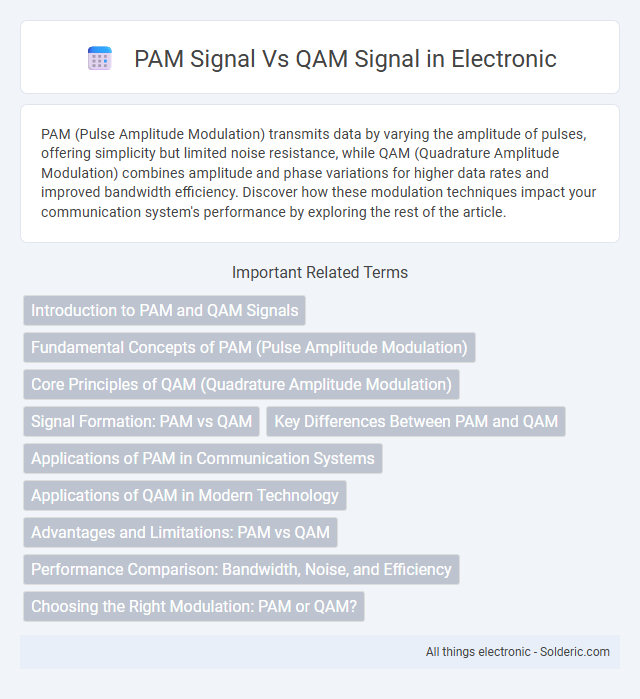PAM (Pulse Amplitude Modulation) transmits data by varying the amplitude of pulses, offering simplicity but limited noise resistance, while QAM (Quadrature Amplitude Modulation) combines amplitude and phase variations for higher data rates and improved bandwidth efficiency. Discover how these modulation techniques impact your communication system's performance by exploring the rest of the article.
Comparison Table
| Feature | PAM (Pulse Amplitude Modulation) | QAM (Quadrature Amplitude Modulation) |
|---|---|---|
| Signal Type | Amplitude-based modulation | Amplitude and phase-based modulation |
| Dimensions | One-dimensional (amplitude only) | Two-dimensional (in-phase and quadrature components) |
| Data Rate | Lower compared to QAM | Higher spectral efficiency and data rates |
| Complexity | Simple implementation | Higher implementation complexity |
| Noise Sensitivity | More susceptible to noise affecting amplitude | Moderate noise sensitivity due to phase and amplitude encoding |
| Applications | Digital telephony, baseband transmission | Broadband communications, Wi-Fi, digital TV |
| Constellation Diagram | Linear amplitude levels | Grid-like constellation combining amplitude and phase |
Introduction to PAM and QAM Signals
Pulse Amplitude Modulation (PAM) encodes information by varying the amplitude of pulses, making it a fundamental technique in digital communication for transmitting data over baseband channels. Quadrature Amplitude Modulation (QAM) combines two amplitude-modulated signals shifted in phase by 90 degrees, effectively doubling the data rate by encoding symbols in both amplitude and phase domains. These modulation schemes are essential in modern digital communication systems where PAM serves simpler signaling needs and QAM supports high spectral efficiency in complex transmission environments.
Fundamental Concepts of PAM (Pulse Amplitude Modulation)
PAM (Pulse Amplitude Modulation) transmits data by varying the amplitude of fixed-width pulses in discrete steps, representing digital symbols. Unlike QAM (Quadrature Amplitude Modulation), which modulates both amplitude and phase of a carrier signal, PAM solely focuses on amplitude changes, simplifying signal processing but offering lower spectral efficiency. Your communication system's performance depends on understanding PAM's fundamental principles, including its susceptibility to noise and bandwidth requirements.
Core Principles of QAM (Quadrature Amplitude Modulation)
Quadrature Amplitude Modulation (QAM) combines amplitude modulation of two carrier waves shifted by 90 degrees, known as the in-phase (I) and quadrature (Q) components, to encode data efficiently. QAM's core principle lies in varying both the amplitude and phase of these carriers to represent multiple bits per symbol, enhancing spectral efficiency compared to Pulse Amplitude Modulation (PAM), which solely varies amplitude. This dual modulation enables QAM to achieve higher data rates and improved bandwidth utilization in communication systems.
Signal Formation: PAM vs QAM
Pulse Amplitude Modulation (PAM) forms signals by varying the amplitude of discrete pulses according to the data points, resulting in one-dimensional amplitude shifts along a single axis. Quadrature Amplitude Modulation (QAM) combines two PAM signals shifted in phase by 90 degrees, modulating both amplitude and phase simultaneously on two orthogonal carriers, creating a two-dimensional constellation map. The dual-axis representation in QAM enables higher data rates and improved spectral efficiency compared to the single-axis amplitude variation in PAM.
Key Differences Between PAM and QAM
PAM (Pulse Amplitude Modulation) signals modulate data by varying the amplitude of pulses along a single dimension, while QAM (Quadrature Amplitude Modulation) combines two amplitude-modulated signals in quadrature, using both amplitude and phase variations to encode data. PAM is simpler and primarily used in baseband systems, whereas QAM offers higher spectral efficiency by transmitting multiple bits per symbol through dual-axis modulation. This fundamental difference makes QAM more suitable for high-data-rate applications like digital TV and broadband internet, in contrast to PAM's limited data capacity.
Applications of PAM in Communication Systems
Pulse Amplitude Modulation (PAM) is widely utilized in baseband data transmission and Ethernet communication systems due to its simplicity and efficiency in representing digital data. PAM signals are crucial in optical fiber communication and digital subscriber line (DSL) technologies where amplitude variations encode information. Unlike Quadrature Amplitude Modulation (QAM), which is more complex and used in high-capacity wireless and broadband systems, PAM's application excels in cost-effective, low-bandwidth environments requiring straightforward signal processing.
Applications of QAM in Modern Technology
QAM (Quadrature Amplitude Modulation) signals are widely used in modern technology for high-speed data transmission in applications such as digital television, cable modems, and 4G/5G wireless communication systems. Unlike PAM (Pulse Amplitude Modulation), QAM combines amplitude and phase variations to transmit multiple bits per symbol, enhancing spectral efficiency and data throughput. The ability of QAM to support higher-order modulation schemes makes it essential for broadband communication networks demanding robust and high-capacity data transfer.
Advantages and Limitations: PAM vs QAM
PAM (Pulse Amplitude Modulation) signals offer simplicity and ease of implementation, making them suitable for short-distance communication with less complex receivers. QAM (Quadrature Amplitude Modulation) signals provide higher spectral efficiency by combining amplitude and phase variations, enabling more data transmission within the same bandwidth and benefiting high-speed digital communication systems. Your choice between PAM and QAM depends on factors like required data rate, noise tolerance, and system complexity, as PAM has limited noise resilience while QAM demands more sophisticated demodulation techniques.
Performance Comparison: Bandwidth, Noise, and Efficiency
PAM (Pulse Amplitude Modulation) signals generally require more bandwidth than QAM (Quadrature Amplitude Modulation) for the same data rate due to their single-carrier amplitude encoding, making QAM more bandwidth-efficient. QAM signals offer better noise immunity and higher spectral efficiency by combining amplitude and phase modulation, allowing more bits per symbol and improved performance in noisy environments. In summary, QAM provides superior performance in bandwidth utilization and noise resilience compared to PAM, making it preferable for high-capacity communication systems.
Choosing the Right Modulation: PAM or QAM?
Choosing the right modulation between PAM (Pulse Amplitude Modulation) and QAM (Quadrature Amplitude Modulation) depends on your system requirements. PAM offers simpler implementation with amplitude-based signaling, making it suitable for lower data rates or less complex systems. QAM provides higher spectral efficiency by combining amplitude and phase modulation, ideal for high data rate applications where bandwidth utilization and signal robustness are critical.
PAM signal vs QAM signal Infographic

 solderic.com
solderic.com